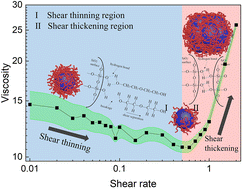Microscopic mechanism study of the rheological behavior of non-Newtonian fluids based on dissipative particle dynamics
Abstract
Non-Newtonian fluid rheological properties are a hot research topic for realizing intelligent applications. In order to investigate the microscopic mechanism and structural evolution process of the nonlinear rheological behavior of non-Newtonian fluids, this paper systematically investigates two continuous nonlinear rheological behaviors of non-Newtonian fluids, namely shear-thickening and shear-thinning rheological properties, using a non-Newtonian fluid system composed of polyethylene glycol (PEG) mixed with nano-silica (Nano-SiO2) by a dissipative particle dynamics (DPD) method. It is shown that at low shear rates, the molecular chains of PEG in the fluid are stretched due to shear flow and the molecular structure is transformed into an ordered state; and the effective hydrodynamic radius of Nano-SiO2 beads decreases, which makes the translational friction coefficient of the beads decrease and the system mobility increases, exhibiting shear-thinning behavior. When the shear rate exceeds the critical value, the contact and collision probability between Nano-SiO2 beads in the non-Newtonian fluid increases; a large number of silicon hydroxyl groups exist on the surface of Nano-SiO2, which form a large number of hydrogen bonds when they are close to each other and constrain the particle separation, resulting in a large aggregation of Nano-SiO2 beads, leading to an increase in the effective kinetic radius of Nano-SiO2 beads and an increase in the coefficient of translational friction, forming a blockage of the fluid system and exhibiting a shear-thickening behavior. Our study provides insights for understanding the rheological behavior of non-Newtonian fluids from a microscopic perspective, and contributes to the intelligent application of non-Newtonian fluids.



 Please wait while we load your content...
Please wait while we load your content...